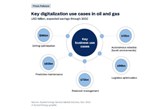GlobalData: Haynesville production rates show refracturing techniques need to evolve
Published by Nicholas Woodroof,
Editor
Oilfield Technology,
A total of 56 wells, which were initially completed between 2008 and 2013, were refractured in Haynesville over the last two years. They had an initial production rate (IP rate) ranging from 320 boe/d to 3500 boe/d. The best outcomes are for wells for which their production rate after refracturing is higher than the initial rate.
Out of the total, the 40 wells refractured by QEP Energy showed a good performance, however in many cases productivities were improved with respect to original rates. Indeed, a total of 22 wells recompleted by QEP Energy reached production rates of at least 1700 boe/d, compared to their first IP rate of no more than 1690 boe/d.
By contrast, Chesapeake recompleted three wells in 2017 with a poor performance since production rates barely reached 1000 boe/d, nonetheless new wells that were recently turned in line by the operator show production rates of approximately 1740 boe/d.
Adrian Lara, Senior Oil & Gas Analyst at GlobalData, commented: “Repeated refracturing of horizontal wells has been much less implemented than vertical refracturing. As a result, there is still a large variance in the results different operators obtain from horizontal well refracturing recompletions.”
The recompleted wells in Haynesville that achieved an improved recompletion rate have a break-even gas price of US$2.54 per thousand cubic feet and a net present value (NPV) of US$7.38 million.
However, for some operators their new wells drilled have better economics than recompleted wells. For instance, Covey Park wells have in average a break-even gas price of US$2.71 per thousand cubic feet versus US$3.12 per thousand cubic feet for its refractured wells, and an NPV of more than US$3.5 million, higher than the one for recompleted wells.
No operator has consistently achieved US$2 million refracturing cost and therefore reaching high production rates remains determinant in having favourable economic performance.
Lara concluded: “Refracturing techniques will need to continue to evolve in Haynesville to increase the success cases and support a shift where refracturing producing wells is as important in the operator’s strategy as is drilling new ones.”
Read the article online at: https://www.oilfieldtechnology.com/hydraulic-fracturing/04092018/globaldata-refracturing-techniques-need-to-evolve/
You might also like
Rystad Energy: Key digital initiatives could save oil and gas industry over US$320 billion
Rystad reports on how digital innovation is changing the oilfield services sector.

